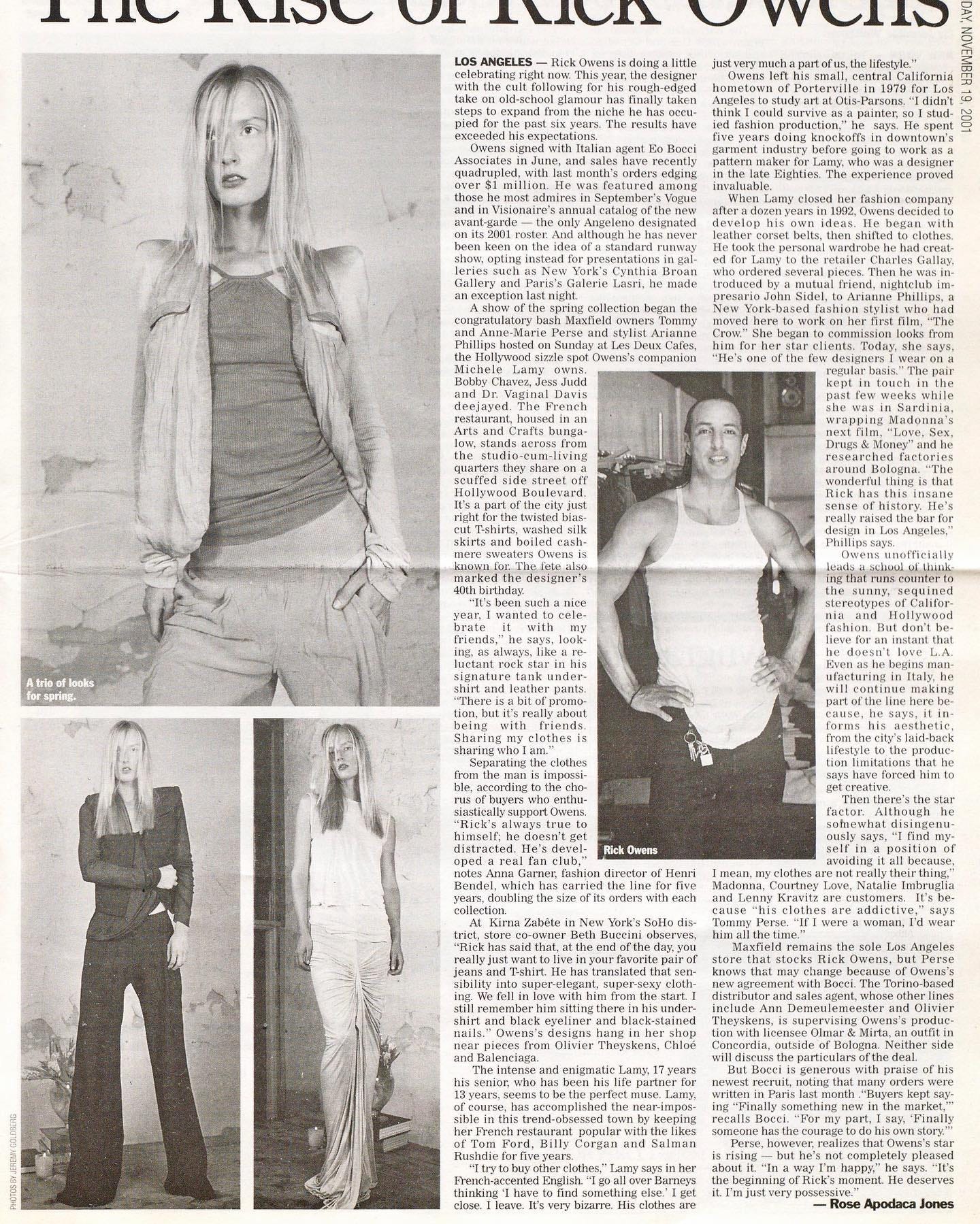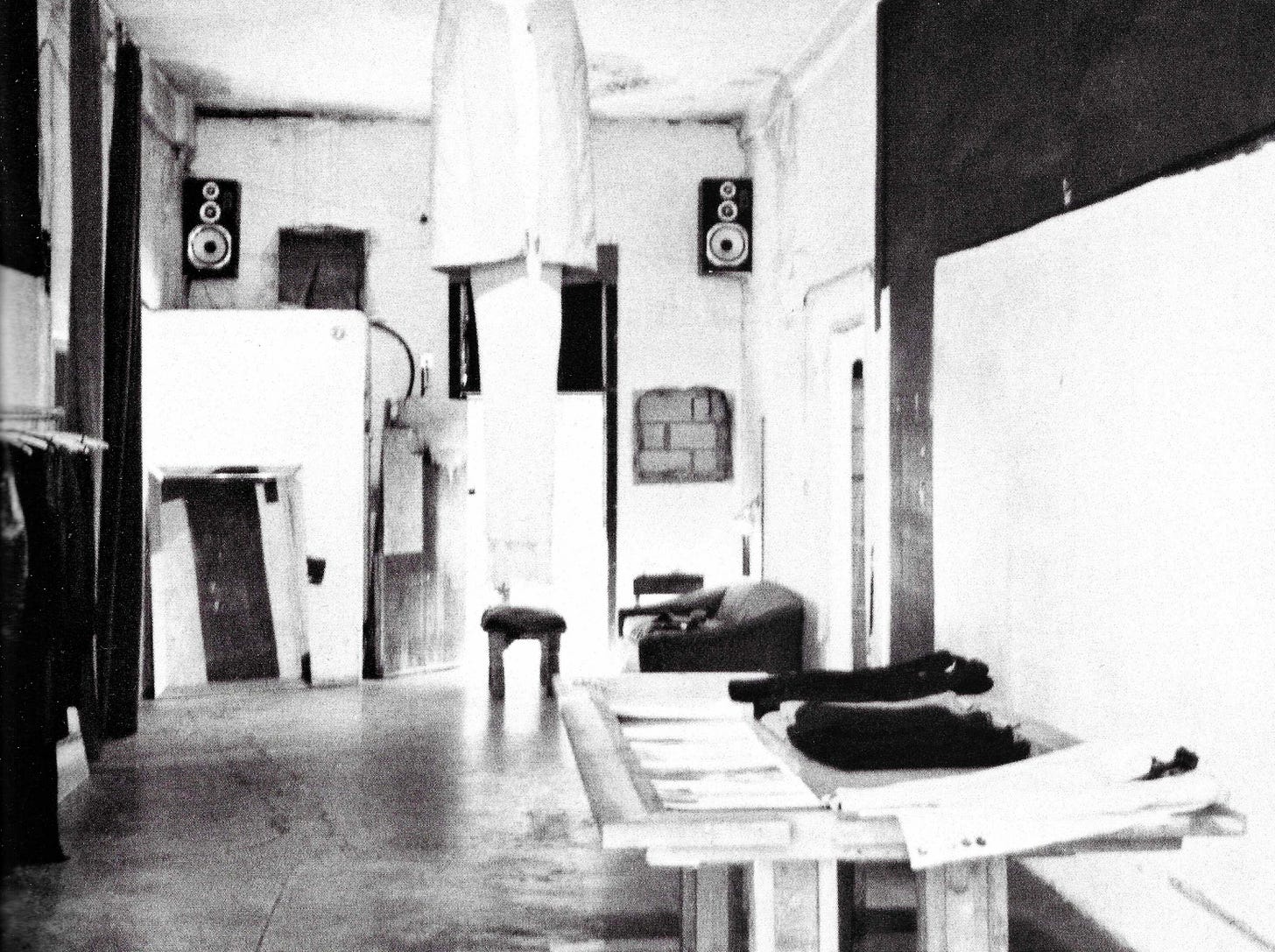Les Deux Cafés: Hollywood's Franco-Gothic Culinary Fever Dream
Remembering Michele Lamy's occult Hollywood restaurant that became an incubator for Rick Owens & Los Angeles fashion and culture
In the subterranean, sleazy limelight of 1990s-era Hollywood, Michele Lamy’s Les Deux Cafés emerged as a hotspot of ostentatious, degenerate glamour. Equal parts Riviera-inspired provençal style bistro and backdoor cabaret, Lamy’s second restaurant in the city of angels quickly became a hotbed for Hollywood gliteratti, scenesters and young fashion creatives – Los Angeles’ very own franco-gothic Studio 54.
But Lamy’s journey to becoming a nightlife impresario had begun much earlier. In 1979, Michele Lamy moved to Los Angeles from France, settling in downtown and starting her knitwear business out of an artist loft. Lamy’s description of LA at the time was ‘New York on the Riviera’, and she had moved to meet her brother, who was already living there – ‘L.A. is easier’, she said in the simplest of terms.1 Lamy would eventually relocate to Hollywood in the late 1980s with her then-husband, filmmaker Richard Newton, and soon after opened her first restaurant on McCadden Place in Hollywood: Cafe des Artistes.
Around the same time, a young designer named Rick Owens would be recommended to Lamy a a pattern marker. Within a few years, the two would become a couple, having their first date at the Stardust Ballroom on Halloween night, 1989. They would move in together soon after, with Owens gaining momentum toward starting his own label, and Lamy slowly shifting focus from her clothing business to the restaurant industry. Tragically, their apartment would be broken into one night, and the couple was held at gunpoint as the assailants took most of their possessions. Lamy and Owens would quickly move to the Chateau Marmont for the next several years, renting a room directly above the kitchen for $3,000 a month.2
While holding residence at the Chateau, Lamy’s fashion line, Too Soon to Know, would enter Chapter 11 bankruptcy in 1993,3 leading her to double down on being a restauranteur. Having departed Cafe des Artistes (condemning it a fate of mediocrity, according to Lamy), she would shift her focus to a new venture, Les Deux Cafés. In no time, Lamy had acquired a parking lot at 1637 N. Las Palmas Ave., the site of a long-abandoned former jazz club, called the Tip Top. Although the site had been secured, Lamy would soon enter a years-long battle with the city over various zoning issues and licenses, eventually winning out and beginning construction in 1995.
Lamy, in concert with famed Los Angeles interior designer Paul Fortune, would build out a garden in the parking lot, adorning it with olive and magnolia trees, as well as a tiled fireplace. Reminiscent of Provençal, the garden was 'dotted with mosaic-top tables and dripping with night-blooming jasmine and eucalyptus’.4 Many tables in the garden were made from hand-crafted glass tiled arabesques, and overhead hung a canopy of Japanese wisteria and grapevines. While diners were to eat in the garden area, the food would be prepared in separate space across the street, and run over. Explaining the decision, Lamy cites the French Riviera tradition of off-site kitchens, ferrying food to diners gazing out over the sea.
Soon after completion of the garden in 1996, the restaurant would soft-open for service. Not content with just this, Lamy simultaneously began refurbishment of the adjacent Tip Top Jazz Club building, which at another point had become the House of Ivy, one of L.A.’s first restaurants catering exclusively to gay clientele. This interior would be converted into the first of Les Deux’s eventual two dining rooms (hence, the two cafes).
The same year, Lamy purchased an abandoned crack house located on Alvarado St., a beautiful, 1904 craftsmen-style abode which had been condemned and slated for demolition. The building was fully lifted off its foundation and relocated to the complex and dropped onto the site to serve as the main indoor dining room. With little to no renovation done to the exterior, it maintained a dystopic, raw urban exoskeleton, and with Fortune’s guidance, the interior would be refurbished and turned into a dark-hued, wood-laden, dimly lit salle à manger. Quoted in the LA Times in 1999, Lamy would say of the decision: “To me, a restaurant has to look like it’s been there forever… Whatever new design you do will be totally passé six months later.”5
Meanwhile, while Les Deux Cafés was undergoing its initial construction and expansion, Owens would re-locate from the Chateau to the his final abode in the City of Angels, 1641 N. Las Palmas, situated across the street from the site of the restaurant. Here Rick would set up his atelier and living quarters, just a few footsteps from Lamy’s restaurant. In a 2017 interview, Owens recalled Lamy walking over to the restaurant’s construction site in "Margiela shoes and one of my bias skirts."6
Finally, in the Spring of 1998, after a string of brief closures due to the expansion, Les Deux Cafés would open for full service in its lime-lit, bohemian entirety. Chef David Wynns was brought in to serve Provençal staples and more general French-fare, such as Artichoke soup, warm oysters au champagne, raclette, skate with brown butter, and veal shank with sweatbread reduction. In the true French tradition, cocktails were not encouraged, with wine and tea pushed heavily, both staples for Lamy. Desserts included strawberry tarts, apple galette, and crème brûlée.
Despite tepid reviews of the alimentary offerings, Les Deux Cafés quickly became Hollywood’s hottest and hardest to get table. Many celebrities soon became regulars, including Al Pacino, Heath Ledger, Nicole Kidman, Ridley Scott, David Lynch, and Lenny Kravitz, while Bill Murray, an investor in the restaurant, would tend bar. Lamy herself, when not smoking or nibbling on a Niçoise salad, would reportedly burst into song later into the nights, akin to a Hollywood-cabaret version of Marlene Dietrich.
Aside from big name regulars, the sixty-seat restaurant became an eclectic mix of Hollywood producers, fashionistas and early Owens’ devotees, becoming a theatrical laboratory of sorts. The staff, rather than merely hired, was cast by Lamy, acting more as performers than waitstaff. The service, slow and abysmal, was constantly subdued to the vibe and general atmosphere of seductive, occult dark glamour, with Lamy reportedly often telling staff “I love chaos” before disappearing into the night, all while hundreds of scene-hungry twenty-somethings clamored for a table while dragging on cigarettes outside the door.
At the height of its popularity in 2001, the restaurant hosted what might imaginably be its peak night, celebrating Rick Owens 40th birthday party, along with a presentation of his new spring collection. The owners of Maxfield boutique (one of Owens’ early stockists), Tommy and Anne-Marie Perse, would host the event alongside Arianne Phillips, stylist for Madonna and movies such the The Crow. Bobby Chavez, Jess Judd and Dr. Vaginal Davis deejayed, rounding out one of many wildly eclectic happenings.
Despite its thespian-laden crowds, Les Deux would ultimately last only until 2004. Chris Wallace, a former bus boy, doorman, and eventual manager of the restaurant, would retroactively define Les Deux Cafés’ golden era as 1999-2002, ending with Owens and Lamy’s relocation to Paris. After winning a prestigious emerging designer award from the CFDA in 2001, French fur house Revillon offered Owens a position as artistic director, one he wouldn’t hesitate to take.
With both Owens and Lamy having left Los Angeles for good, Les Deux Cafés would sputter on for two more aimless years, devoid of its heartbeat and chaotic energy. The doors would eventually close in 2004, bringing an end to a golden era, or at least the one that shone on this little block of Las Palmas Avenue in Hollywoodland.
Lacher, Irene. "Une Petite Party." Los Angeles Times, 22 Nov. 1999
Lacher, Irene. "Une Petite Party." Los Angeles Times, 22 Nov. 1999











